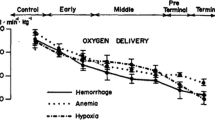Abstract
We evaluated the short-term variability of Pao 2, Paco 2, pulse oximeter saturation (Spo 2), and end-tidalPco 2 (Petco 2) in mechanically ventilated trauma patients. All patients were stable and undisturbed during the evaluation periods. Blood gases were obtained from an arterial catheter 4 times at 20-minute intervals.Spo 2 andPetco 2 were recorded when the blood gases were obtained. Fifty evaluations were made in 26 patients; 24 patients were evaluated twice, with ≥24 hours between evaluation periods. Variability was expressed as coefficient of variation (%CV) for each evaluation period. The median %CVs were 3.6% for Pao 2 (95th percentile = 9.8%), 0.5% forSpo 2 (95th percentile = 1.4%), 2.8% for Paco 2 (95th percentile = 7.4%), and 2.4% forPetco 2 (95th percentile = 7.1%). The overall correlation between Paco 2 andPetco 2 wasr=0.80, and the mean difference between Paco 2 andPetco 2 was 0.9±3.6 mm Hg. The variability ofPetco 2 was similar to the variability of Paco 2. However, the variability of Pao 2 was considerably greater than that ofSpo 2, which was probably related to the shape of the oxyhemoglobin dissociation curve and the relatively high saturations of the patients in this study. Variability of blood gases,Spo 2, andPetco 2 should be considered when these values are clinically interpreted.
Similar content being viewed by others
References
Thorson SH, Marini JJ, Pierson DJ, et al. Variability of arterial blood gas values in stable patients in the ICU. Chest 1983;84:14–18
Wagener JS, Hendricker C. Intra-subject variability of noninvasive oxygen measurements. Chest 1987;92:1047–1049
Blood gas preanalytical considerations: specimen collection, calibration, and controls. NCCLS Document C27-T, NCCLS, Villanova, PA, 1989
Elser RC. Quality control of blood gas analysis: a review. Respir Care 1986;31:807–816
Andritch RF, Ruravchick S, Gold MI. Temperature correction of arterial blood-gas parameters: a comparative review of methodology. Anesthesiology 1981; 55:311–316
Brooks SM, Mintz S, Weiss EB. Patterns of responses to bronchodilators in patients with bronchial asthma. J Lab Clin Med 1972;79:267–276
MacKersie RC, Karagianes TG. Use of end-tidal carbon dioxide tension for monitoring induced hypocapnia in head-injured patients. Crit Care Med 1990;18:764–765
Moorthy SS, Losasso AM, Wilcox J. End-tidal PCO2 greater than PaCO2. Crit Care Med 1984;12:534–535
Shankar KB, Moseley H, Kumar Y. Arterial to end tidal carbon dioxide differences during caesarean section anesthesia. Anesthesia 1986;41:678–702
Shapiro BA, Cane RD, Chomka CM, et al. Preliminary evaluation of an intra-arterial blood gas system in dogs and humans. Crit Care Med 1989;17:455–460
Donati F, Maille J, Blain R, et al. End-tidal carbon dioxide tension and temperature changes after coronary artery bypass surgery. Can Anaesth Soc J 1985;32:272–277
Phan CQ, Tremper KK, Lee SE, et al. Noninvasive monitoring of carbon dioxide: a comparison of the partial pressure of transcutaneous and end-tidal carbon dioxide with the partial pressure of arterial carbon dioxide. J Clin Monit 1987;3:149–154
Whitesell R, Asiddao C, Gollman D, et al. Relationship between arterial and peak expiratory carbon dioxide pressure during anesthesia and factors influencing the difference. Anesth Analg 1981;60:508–512
Author information
Authors and Affiliations
Rights and permissions
About this article
Cite this article
Hess, D., Agarwal, N.N. Variability of blood gases, pulse oximeter saturation, and end-tidal carbon dioxide pressure in stable, mechanically ventilated trauma patients. J Clin Monitor Comput 8, 111–115 (1992). https://doi.org/10.1007/BF01617428
Received:
Revised:
Accepted:
Issue Date:
DOI: https://doi.org/10.1007/BF01617428




